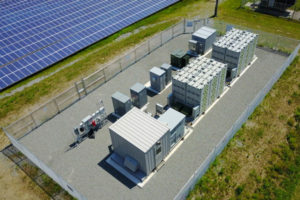Design & Modeling of Hybrid Energy Storage Enabled Microgrids for DoD Installations - Phase II
 350Solutions is providing technical support to Arizona State University under a Phase II project sponsored by Environmental Security Technology Certification Program (ESTCP) for design and modeling of hybrid energy storage enabled microgrids for Department of Defense (DoD). This project will optimize and demonstrate in laboratory settings energy storage implementation in relevant DoD microgrid applications. Integrated modeling and design methods optimize a microgrid that can contain multiple energy storage asset types – a hybrid energy storage system (HESS) approach – in conjunction with diesel and renewable generation platforms.
350Solutions is providing technical support to Arizona State University under a Phase II project sponsored by Environmental Security Technology Certification Program (ESTCP) for design and modeling of hybrid energy storage enabled microgrids for Department of Defense (DoD). This project will optimize and demonstrate in laboratory settings energy storage implementation in relevant DoD microgrid applications. Integrated modeling and design methods optimize a microgrid that can contain multiple energy storage asset types – a hybrid energy storage system (HESS) approach – in conjunction with diesel and renewable generation platforms.
Objectives
This project will demonstrate a storage-enabled microgrid that enhances installation energy security with greater autonomy during a grid outage and reduces operating costs during grid-connected operation. Delivering resilience with a return on investment, the work offers a cost-effective way to achieve broad DoD and branch-specific objectives for 7 to 14-day mission autonomy while also providing a variety of business models and controls approaches to improve financial return and adapt to specific installation needs. The approach will evaluate single energy storage asset and hybrid energy storage systems that integrate multiple storage technologies to value-stack benefits in site-customized DoD microgrids.
Technologies
Primary components of the system include short-duration storage (Skeleton Technology ultracapacitors) that are integrated with medium-term storage (Blue Planet Energy Lithium Ferrous Phosphate) to value-stack the benefits in site-customized DoD microgrids. One or more legacy generators are integrated into the system and any existing solar photovoltaic is also integrated. The controller developed by Arizona State University and Ageto provides main capabilities for (a) operating in parallel with the grid to achieve economic savings, (b) operating during grid outage to increase mission survivability and mission autonomy, and (c) reliably and stably transitioning between grid-connected to islanded mode, and back. The controls approach provides flexibility for behind-the-meter and in-front-of-the-meter applications and can be easily configured for operation with different combinations and sizes of assets.
Benefits
Project benefits for the ESTCP site locations have general applicability to DoD installations using empirical testing that demonstrates how the solution can be adapted to other sites.
- Increased resilience – Surpass minimum seven-day autonomy requirements during grid outage.
- Improved economics – Reduce energy and operation and maintenance costs as directed by ESTCP and DoD Energy Policy, and further, to permit revenue generation through access to ancillary services markets.
- Increased battery life – Demonstrate ultracapacitors paired with battery storage to improve lifetime of batteries, and therein improve project economics.
- Greater decision making – Controls enhancement allows an operator to make real-time mission changes and load prioritization decisions to maintain/improve survivability during outage.
- Increased flexibility – Adapt to many installation locations and legacy assets using a technology agnostic approach that includes interoperability with over 60 types of assets and controls that are abstracted to be applied in behind-the-meter and in-front-of-the-meter markets. Further, the solution can more generally address DoD goals for adaptive basing as outlined in the National Defense Strategy.
- Technology agnostic – Interoperability with legacy assets and new assets, with vendor registers mapped to high-level control strategy. Mitigate risk to vendor cost and technology changes.
- Mitigate risk to fuel shortage – Demonstrate that solar + storage improves survivability of a diesel-only microgrid, even when fewer generators are available.
Project Details
- Client: Arizona State University/ DoD ESTCP
- Period : 2021
- Project Type : Testing, Analysis
- Scale : Controller hardware in loop (CHIL) and power hardware in loop (PHIL)
Important Points
- Optimized microgrid can reduce net cost to protect critical load by 21-62%
- Ability to provide 24 to 168 hr critical load coverage can be improved with optimized storage-enabled microgrid
- Proper microgrid design can reduce annual energy costs by over 15%
